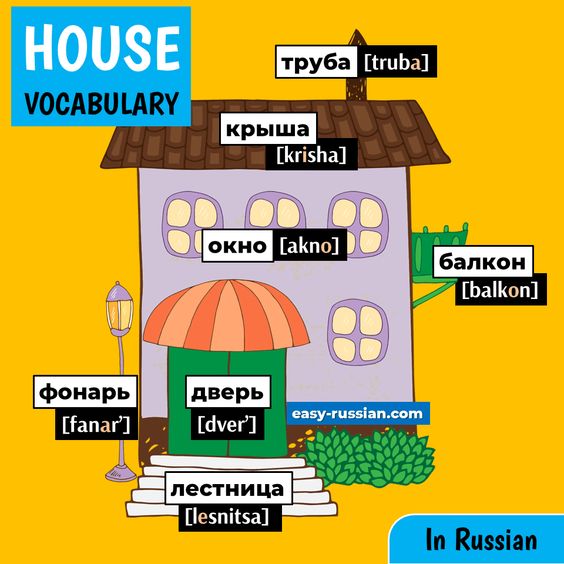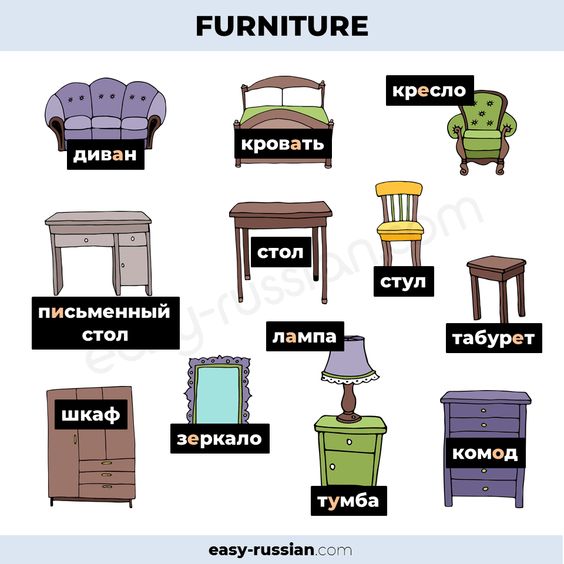Rooms, Furniture and Things Around the House: Russian Vocabulary
There are so many things you can find in your own home. But can you name them all in Russian? I doubt it. Even I, being Russian myself, can’t. Well, at least we can learn the basics. That’s what we’ll do today.
When learning a language, having a solid foundation in basic vocabulary is essential for effective communication, and this holds particularly true for daily life scenarios within the home.
In this article, we will explore the essential Russian vocabulary that every learner should know when it comes to describing the different rooms in a house (дом), identifying furniture items, and discussing various objects commonly found within a living space.
Let’s start with rooms.
Rooms in Russian
Most Russians live in small houses and apartments because the cost of real estate is very high. A typical one-room apartment, also known as a “квартира-студия” [kvarteera-stoodeeya] or “однокомнатная квартира” [adnakomnatnaya kvarteera] in Russian, usually features an open-plan layout where multiple functions are combined within a single room. It functions as a living area, bedroom, and sometimes a dining area or workspace.
комната [komnata] – room
коридор [kareedor] – corridor
прихожая [preekhozhaya] – hallway
гостиная [gasteenaya] – living-room
спальня [spalnya] – bedroom
кухня [kookhnya] – kitchen
ванная (комната) [vannaya komnata] – bathroom
веранда [veeranda] – verandah
кладовая [kladovaya] – pantry
See Also: Kitchen Vocabulary in Russian
Parts of the house (inside and outside)
A typical Russian country house, especially older ones made of wood, has a charming and rustic appearance. These houses are often constructed using logs or timber, with thick, horizontally stacked walls. The roofs are steeply pitched with gables, allowing for efficient snow shedding.

Traditional Russian country houses may feature decorative elements like carved window frames and geometric patterns. Many houses have a porch or veranda, providing outdoor gathering areas. Inside, these houses offer spacious living areas with high ceilings and open layouts.
Furnishings often include handcrafted wooden furniture and traditional textiles, creating a cozy and warm atmosphere. It’s worth noting that modern country houses in Russia may blend traditional elements with contemporary design features for comfortable and functional living spaces.
крыша [krisha] – roof
труба [trooba], дымоход [dimakhod] – chimney
балкон [balkon] – balcony
стена [steena] – wall
окно [akno] – window; окна [okna] – windows
ставня [stavnya] – shutter
подоконник [padakonnik] – window sill
дверь [dvyer’] – door
(дверной) косяк [dvyernoy kasyak] – (door) jamb
дверная ручка [dvyernaya roochka] – door handle / door knob
(дверной) звонок [dvyernoj zvanok] – (door) bell
пол [pol] – floor
потолок [patalok] – ceiling

Furniture
The furniture found in Russian houses is generally similar to what you would find in houses in many other countries. It includes common furniture pieces like tables, chairs, sofas, beds, wardrobes, and shelves. These items serve essential functions and provide comfort and functionality for daily living.
диван [deevan] – sofa
угловой диван [ooglavoj deevan] – corner sofa
кресло [kryesla] – armchair
стул [stool] – chair
табурет [tabooryet] – stool
кровать [kravat’] – bed
стол [stol] – table
письменный стол [pees’myeniy stol] – desk
компьютерный стол [kampyuterniy stol] – computer desk
полка [polka] – shelf
книжные полки [kneezhniye polkee] – bookshelves
шкаф [shkaf] – closet, cabinet
книжный шкаф [kneezhniy shkaf] – bookcase
гардероб [gardyerob] – wardrobe
вешалка [vyeshalka] – peg rack, hanger
буфет [boofyet], шкафчик [shkafcheek] – cupboard
кухонный гарнитур [kookhaniy garneetoor] – kitchen unit
тумба [toomba], тумбочка [toombachka] – bedside table
комод [kamot] – chest of drawers
зеркало [zyerkala] – mirror

Now, let’s talk about the famous Russian “стенка” [styenka], which is a unique and iconic piece of furniture commonly found in Russian homes. A стенка is a massive wall unit or modular shelving system that serves multiple functions. It typically consists of shelves, cabinets, drawers, and sometimes even a built-in desk.
The стенка is designed to offer ample storage space for books, electronics, decorative items, and to house a television. It is not only practical but also serves as a centerpiece and focal point in the living room or home office. This piece of furniture can have various designs, from classic and ornate to modern and minimalist, depending on personal preferences and interior design styles.

Other things around the house
лампа [lampa] – lamp
люстра [lyustra] – chandelier
ковёр [kavyor] – carpet
коврик [kovreek] – rug
торшер [tarsher] – floor lamp
шторы [shtori] – curtains
жалюзи [zhalyuzee] – blinds
розетка [razyetka] – plug
выключатель [viklyuchatyel’] – light switch
камин [kameen] – fireplace
картина [karteena] – picture
Kitchen and Bathroom
холодильник [haladeel’neek] – refrigerator
плита [pleeta] – cooker
вытяжка [vityazhka] – kitchen hood
духовка [dookhofka] – oven
раковина [rakaveena] – sink
кран [kran] – tap
посудомоечная машина [pasoodamoyechnaya mashina] – dishwasher
стиральная машина [steeral’naya mashina] – washing machine
унитаз [ooneetas] – toilet
ванна [vanna] – bathtub
See Also: Bathroom and Hygiene Vocabulary in Russian
Outside the house
сад [sat] – garden
забор [zabor] – fence
гараж [garazh] – garage
почтовый ящик [pachtoviy yashcheek] – mailbox
In the video below you can hear the pronunciation of every word I listed in this article.
Understanding this fundamental vocabulary is vital for navigating everyday conversations, describing living spaces, and expressing preferences and needs related to the home environment. By familiarizing yourself with these key terms, you will gain the ability to engage in discussions about your living arrangements, plan interior design, and have meaningful conversations about household tasks and routines with native Russian speakers.
